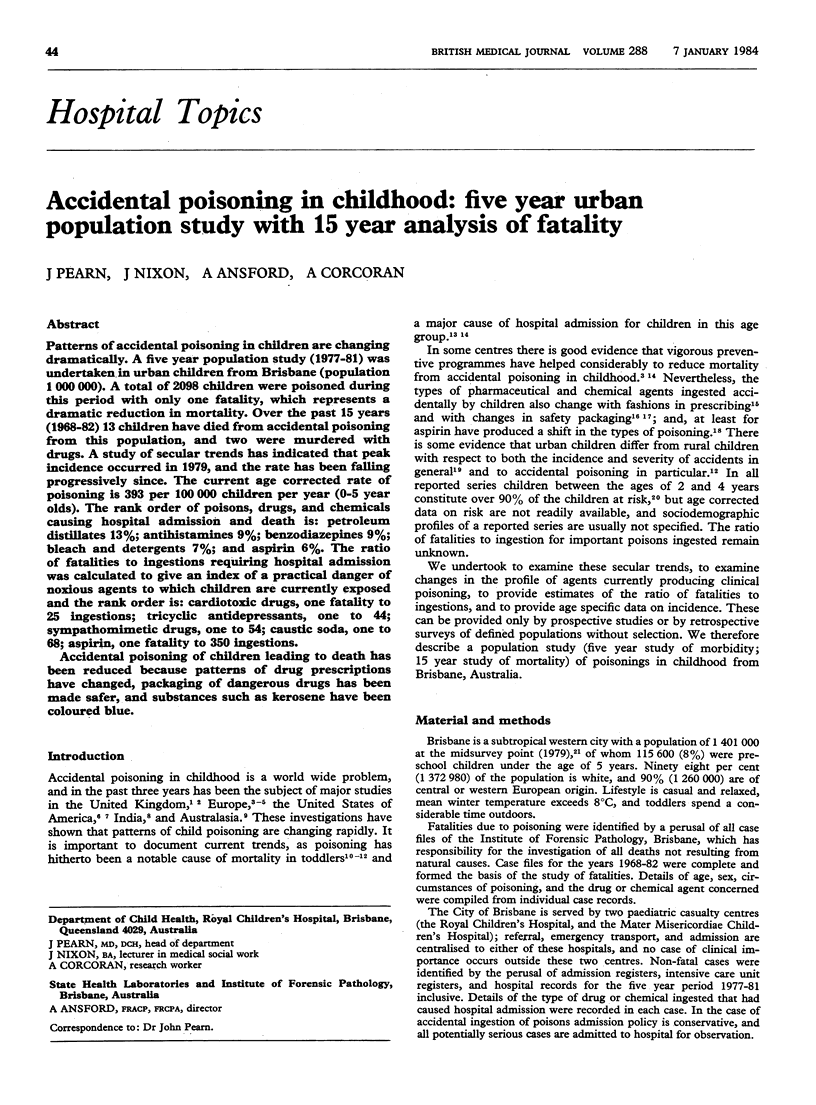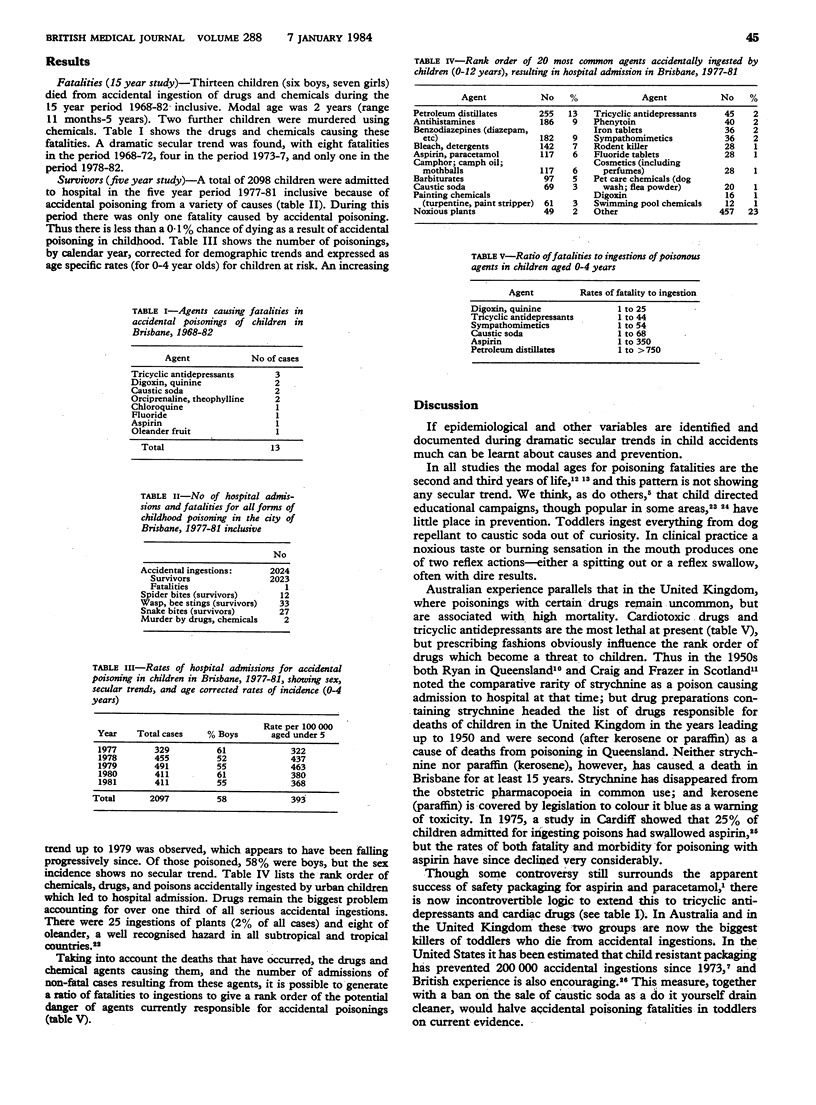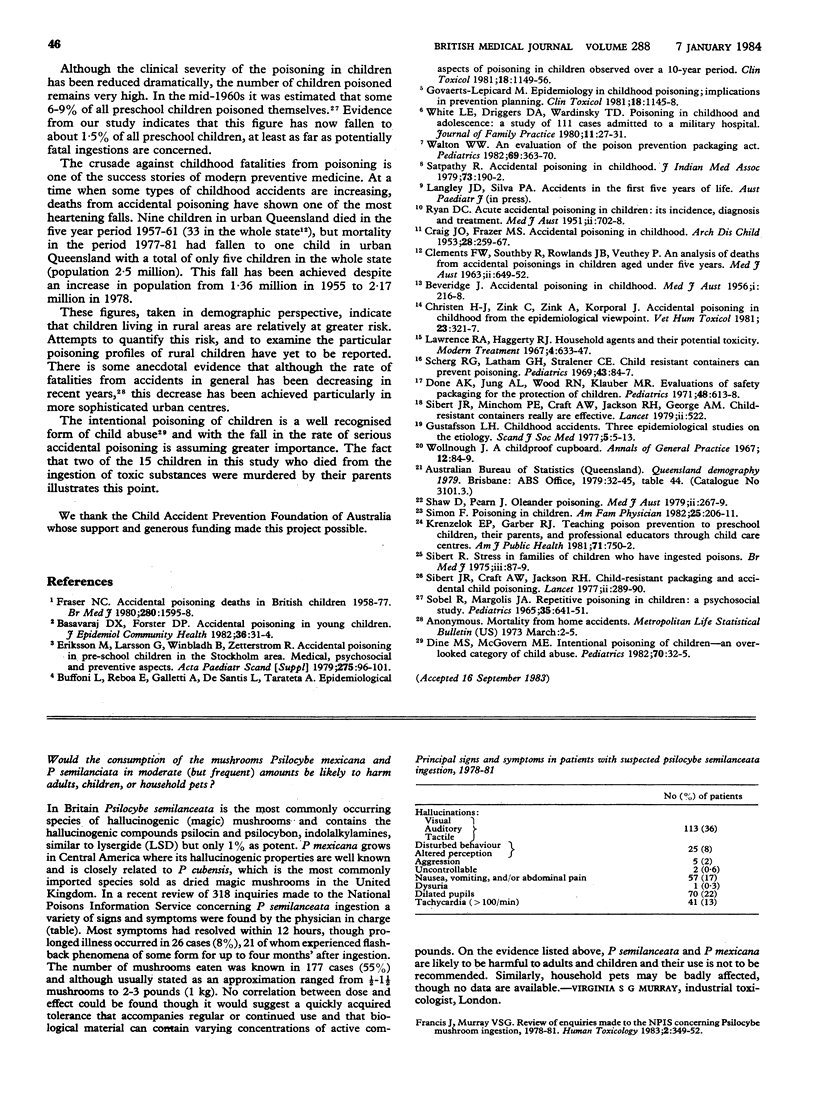Abstract
Patterns of accidental poisoning in children are changing dramatically. A five year population study (1977-81) was undertaken in urban children from Brisbane (population 1 000 000). A total of 2098 children were poisoned during this period with only one fatality, which represents a dramatic reduction in mortality. Over the past 15 years (1968-82) 13 children have died from accidental poisoning from this population, and two were murdered with drugs. A study of secular trends has indicated that peak incidence occurred in 1979, and the rate has been falling progressively since. The current age corrected rate of poisoning is 393 per 100 000 children per year (0-5 year olds). The rank order of poisons, drugs, and chemicals causing hospital admission and death is: petroleum distillates 13%; antihistamines 9%; benzodiazepines 9%; bleach and detergents 7%; and aspirin 6%. The ratio of fatalities to ingestions requiring hospital admission was calculated to give an index of a practical danger of noxious agents to which children are currently exposed and the rank order is: cardiotoxic drugs, one fatality to 25 ingestions; tricyclic antidepressants, one to 44; sympathomimetic drugs, one to 54; caustic soda, one to 68; aspirin, one fatality to 350 ingestions. Accidental poisoning of children leading to death has been reduced because patterns of drug prescriptions have changed, packaging of dangerous drugs has been made safer, and substances such as kerosene have been coloured blue.
Full text
PDF


Selected References
These references are in PubMed. This may not be the complete list of references from this article.
- BEVERIDGE J. Accidental poisoning in childhood. Med J Aust. 1956 Feb 11;43(6):216–218. [PubMed] [Google Scholar]
- Basavaraj D. S., Forster D. P. Accidental poisoning in young children. J Epidemiol Community Health. 1982 Mar;36(1):31–34. doi: 10.1136/jech.36.1.31. [DOI] [PMC free article] [PubMed] [Google Scholar]
- Buffoni L., Reboa E., Galletti A., De Santis L., Tarateta A. Epidemiological aspects of poisoning in children observed over a 10-year period. Clin Toxicol. 1981 Oct;18(10):1149–1156. doi: 10.3109/00099308109035054. [DOI] [PubMed] [Google Scholar]
- CLEMENTS F. W., SOUTHBY R., ROWLANDS J. B., VEUTHEY P. AN ANALYSIS OF DEATHS FROM ACCIDENTAL POISONINGS IN CHILDREN AGED UNDER FIVE YEARS. Med J Aust. 1963 Oct 19;2:649–652. [PubMed] [Google Scholar]
- CRAIG J. O., FRASER M. S. Accidental poisoning in childhood. Arch Dis Child. 1953 Aug;28(140):259–267. doi: 10.1136/adc.28.140.259. [DOI] [PMC free article] [PubMed] [Google Scholar]
- Christen H. J., Zink C., Zink A., Korporal J. Accidental poisoning in childhood from the epidemiological viewpoint-An analysis of 323 cases of poisoning in children under eight years of age-. Vet Hum Toxicol. 1981 Oct;23(5):321–327. [PubMed] [Google Scholar]
- Dine M. S., McGovern M. E. Intentional poisoning of children--an overlooked category of child abuse: report of seven cases and review of the literature. Pediatrics. 1982 Jul;70(1):32–35. [PubMed] [Google Scholar]
- Done A. K., Jung A. L., Wood M. C., Klauber M. R. Evaluations of safety packaging for the protection of children. Pediatrics. 1971 Oct;48(4):613–628. [PubMed] [Google Scholar]
- Francis J., Murray V. S. Review of enquiries made to the NPIS concerning Psilocybe mushroom ingestion, 1978--1981. Hum Toxicol. 1983 Apr;2(2):349–352. doi: 10.1177/096032718300200229. [DOI] [PubMed] [Google Scholar]
- Fraser N. C. Accidental poisoning deaths in British children 1958-77. Br Med J. 1980 Jun 28;280(6231):1595–1598. doi: 10.1136/bmj.280.6231.1595. [DOI] [PMC free article] [PubMed] [Google Scholar]
- Govaerts-Lepicard M. Epidemiology in childhood poisoning: implications in prevention planning. Clin Toxicol. 1981 Oct;18(10):1145–1148. doi: 10.3109/00099308109035053. [DOI] [PubMed] [Google Scholar]
- Gustafsson L. H. Childhood accidents. Three epidemiological studies on the etiology. Scand J Soc Med. 1977;5(1):5–13. doi: 10.1177/140349487700500102. [DOI] [PubMed] [Google Scholar]
- Krenzelok E. P., Garber R. J. Teaching poison prevention to preschool children, their parents, and professional educators through child care centers. Am J Public Health. 1981 Jul;71(7):750–752. doi: 10.2105/ajph.71.7.750. [DOI] [PMC free article] [PubMed] [Google Scholar]
- Lawrence R. A., Haggerty R. J. Household agents and their potential toxicity. Mod Treat. 1967 Jul;4(4):633–647. [PubMed] [Google Scholar]
- RYAN D. C. Acute accidental poisoning in children; its incidence, diagnosis and treatment. Med J Aust. 1951 Nov 24;2(21):702–708. [PubMed] [Google Scholar]
- SOBEL R., MARGOLIS J. A. REPETITIVE POISONING IN CHILDREN: A PSYCHOSOCIAL STUDY. Pediatrics. 1965 Apr;35:641–651. [PubMed] [Google Scholar]
- Satpathy R., Das B. B. Accidental poisoning in childhood. J Indian Med Assoc. 1979 Dec 1;73(11):190–192. [PubMed] [Google Scholar]
- Scherz R. G., Latham G. H., Stracener C. E. Child-resistant containers can prevent poisoning. Pediatrics. 1969 Jan;43(1):84–87. [PubMed] [Google Scholar]
- Shaw D., Pearn J. Oleander poisoning. Med J Aust. 1979 Sep 8;2(5):267–269. doi: 10.5694/j.1326-5377.1979.tb127135.x. [DOI] [PubMed] [Google Scholar]
- Sibert J. R., Craft A. W., Jackson R. H. Child-resistant packaging and accidental child poisoning. Lancet. 1977 Aug 6;2(8032):289–290. doi: 10.1016/s0140-6736(77)90966-7. [DOI] [PubMed] [Google Scholar]
- Sibert J. R., Minchom P. E., Craft A. W., Jackson R. H., George A. M. Child-resistant containers really are effective. Lancet. 1979 Sep 8;2(8141):522–522. doi: 10.1016/s0140-6736(79)91572-1. [DOI] [PubMed] [Google Scholar]
- Simon F. Poisoning in children. Am Fam Physician. 1982 Feb;25(2):206–211. [PubMed] [Google Scholar]
- Walton W. W. An evaluation of the Poison Prevention Packaging Act. Pediatrics. 1982 Mar;69(3):363–370. [PubMed] [Google Scholar]
- White L. E., Driggers D. A., Wardinsky T. D. Poisoning in childhood and adolescence: a study of 111 cases admitted to a military hospital. J Fam Pract. 1980 Jul;11(1):27–31. [PubMed] [Google Scholar]


